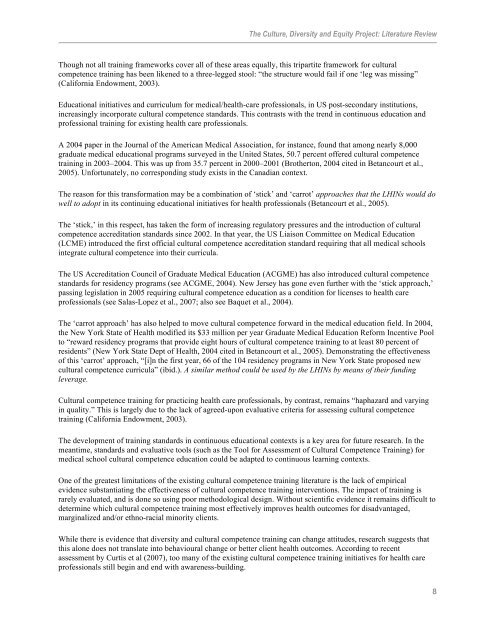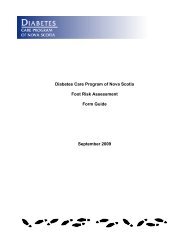CDE Appendix 1 Literature Review - Central East Local Health ...
CDE Appendix 1 Literature Review - Central East Local Health ...
CDE Appendix 1 Literature Review - Central East Local Health ...
Create successful ePaper yourself
Turn your PDF publications into a flip-book with our unique Google optimized e-Paper software.
The Culture, Diversity and Equity Project: <strong>Literature</strong> <strong>Review</strong><br />
Though not all training frameworks cover all of these areas equally, this tripartite framework for cultural<br />
competence training has been likened to a three-legged stool: “the structure would fail if one ‘leg was missing”<br />
(California Endowment, 2003).<br />
Educational initiatives and curriculum for medical/health-care professionals, in US post-secondary institutions,<br />
increasingly incorporate cultural competence standards. This contrasts with the trend in continuous education and<br />
professional training for existing health care professionals.<br />
A 2004 paper in the Journal of the American Medical Association, for instance, found that among nearly 8,000<br />
graduate medical educational programs surveyed in the United States, 50.7 percent offered cultural competence<br />
training in 2003–2004. This was up from 35.7 percent in 2000–2001 (Brotherton, 2004 cited in Betancourt et al.,<br />
2005). Unfortunately, no corresponding study exists in the Canadian context.<br />
The reason for this transformation may be a combination of ‘stick’ and ‘carrot’ approaches that the LHINs would do<br />
well to adopt in its continuing educational initiatives for health professionals (Betancourt et al., 2005).<br />
The ‘stick,’ in this respect, has taken the form of increasing regulatory pressures and the introduction of cultural<br />
competence accreditation standards since 2002. In that year, the US Liaison Committee on Medical Education<br />
(LCME) introduced the first official cultural competence accreditation standard requiring that all medical schools<br />
integrate cultural competence into their curricula.<br />
The US Accreditation Council of Graduate Medical Education (ACGME) has also introduced cultural competence<br />
standards for residency programs (see ACGME, 2004). New Jersey has gone even further with the ‘stick approach,’<br />
passing legislation in 2005 requiring cultural competence education as a condition for licenses to health care<br />
professionals (see Salas-Lopez et al., 2007; also see Baquet et al., 2004).<br />
The ‘carrot approach’ has also helped to move cultural competence forward in the medical education field. In 2004,<br />
the New York State of <strong>Health</strong> modified its $33 million per year Graduate Medical Education Reform Incentive Pool<br />
to “reward residency programs that provide eight hours of cultural competence training to at least 80 percent of<br />
residents” (New York State Dept of <strong>Health</strong>, 2004 cited in Betancourt et al., 2005). Demonstrating the effectiveness<br />
of this ‘carrot’ approach, “[i]n the first year, 66 of the 104 residency programs in New York State proposed new<br />
cultural competence curricula” (ibid.). A similar method could be used by the LHINs by means of their funding<br />
leverage.<br />
Cultural competence training for practicing health care professionals, by contrast, remains “haphazard and varying<br />
in quality.” This is largely due to the lack of agreed-upon evaluative criteria for assessing cultural competence<br />
training (California Endowment, 2003).<br />
The development of training standards in continuous educational contexts is a key area for future research. In the<br />
meantime, standards and evaluative tools (such as the Tool for Assessment of Cultural Competence Training) for<br />
medical school cultural competence education could be adapted to continuous learning contexts.<br />
One of the greatest limitations of the existing cultural competence training literature is the lack of empirical<br />
evidence substantiating the effectiveness of cultural competence training interventions. The impact of training is<br />
rarely evaluated, and is done so using poor methodological design. Without scientific evidence it remains difficult to<br />
determine which cultural competence training most effectively improves health outcomes for disadvantaged,<br />
marginalized and/or ethno-racial minority clients.<br />
While there is evidence that diversity and cultural competence training can change attitudes, research suggests that<br />
this alone does not translate into behavioural change or better client health outcomes. According to recent<br />
assessment by Curtis et al (2007), too many of the existing cultural competence training initiatives for health care<br />
professionals still begin and end with awareness-building.<br />
8

















